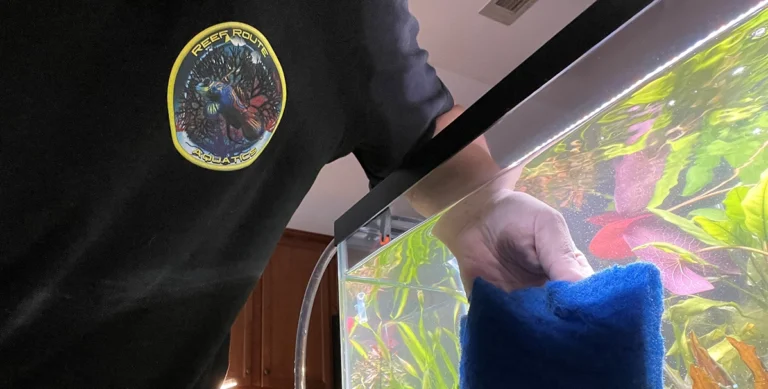Why Regular Fish Tank Cleaning is Essential for a Healthy Aquarium
Are you a proud fish owner, looking to create a healthy and thriving environment for your aquatic friends? If so, then regular fish tank cleaning is an essential task that cannot be overlooked. A clean aquarium not only enhances the visual appeal of your home or office space but also plays a crucial role in maintaining the overall well-being of your fish. Neglecting regular cleaning can lead to a buildup of harmful toxins, such as ammonia and nitrites, which can have detrimental effects on your fish’s health. Additionally, dirty water can promote the growth of harmful bacteria and algae, leading to various diseases and unsightly conditions. By implementing a proper cleaning routine, you not only ensure a beautiful and vibrant aquarium but also provide a safe and healthy habitat for your beloved aquatic companions. In this article, we will explore the importance of regular fish tank cleaning and provide you with valuable tips to maintain a thriving aquarium.

Importance of Regular Fish Tank Cleaning
Keeping your fish tank clean is essential for the overall health and well-being of your fish. Regular cleaning helps to eliminate harmful toxins, maintain water quality, and prevent the growth of bacteria and algae. Here are some key reasons why regular fish tank cleaning is of utmost importance:
1. Eliminates Harmful Toxins
One of the primary reasons for regular fish tank cleaning is to eliminate harmful toxins that can accumulate in the water. Fish produce waste in the form of ammonia, which is highly toxic and can be fatal if levels become too high. Additionally, uneaten food, decaying plants, and other organic matter can also contribute to the buildup of toxins. Regular cleaning helps to remove these contaminants and keeps the water clean and safe for your fish.
2. Maintains Water Quality
Maintaining good water quality is crucial for the health of your fish. Dirty water can become cloudy, foul-smelling, and oxygen-deprived, which can stress your fish and make them more susceptible to diseases. Regular cleaning, including water changes, helps to maintain proper pH levels, dissolved oxygen levels, and overall water chemistry, creating an optimal environment for your fish to thrive.
3. Prevents Bacterial and Algal Growth
Dirty fish tanks provide a breeding ground for harmful bacteria and algae. Bacteria can cause various diseases, while algae can make your tank look unsightly and disrupt the balance of the ecosystem. Regular cleaning, including scrubbing the tank walls and removing algae, helps to prevent the growth of these unwanted organisms and ensures a clean and healthy environment for your fish.
Benefits of a Clean Fish Tank
A clean fish tank offers numerous benefits, both for your fish and for your own enjoyment. Here are some key advantages of maintaining a clean aquarium:
1. Enhanced Visual Appeal
A clean fish tank not only looks beautiful but also enhances the overall aesthetic appeal of your home or office space. Clear water, vibrant plants, and healthy fish contribute to a visually pleasing environment that can be enjoyed by everyone who sees it.
2. Reduced Risk of Diseases
Regular cleaning helps to eliminate toxins, bacteria, and other contaminants that can cause diseases in your fish. By maintaining a clean and healthy environment, you greatly reduce the risk of your fish falling ill and increase their chances of living a long and happy life.
3. Improved Fish Behavior
Fish that live in a clean and well-maintained tank are generally happier and more active. They exhibit natural behaviors, such as swimming, exploring, and interacting with their surroundings. A clean tank provides them with a stress-free environment, allowing them to exhibit their natural behaviors to the fullest.
4. Easier Maintenance
Regular cleaning makes the overall maintenance of your fish tank much easier. By staying on top of cleaning tasks, such as water changes and filter maintenance, you prevent the accumulation of dirt and debris, reducing the amount of time and effort required to keep your tank in optimal condition.
Common Problems Caused by Dirty Fish Tanks
Neglecting regular fish tank cleaning can lead to a variety of problems that can negatively impact the health and well-being of your fish. Here are some common problems caused by dirty fish tanks:
1. Ammonia Poisoning
Ammonia is a toxic substance produced by fish waste and decaying matter. In a dirty tank, ammonia levels can rise to dangerous levels, leading to ammonia poisoning. Symptoms of ammonia poisoning include lethargy, loss of appetite, inflammation of the gills, and red streaks on the fins. If left untreated, ammonia poisoning can be fatal to your fish.
2. Nitrite Poisoning
Nitrites are produced as a byproduct of the breakdown of ammonia in the nitrogen cycle. In a dirty tank, nitrite levels can increase, leading to nitrite poisoning. Symptoms of nitrite poisoning include rapid breathing, lethargy, loss of appetite, and dark-colored gills. Nitrite poisoning can be fatal to your fish if not addressed promptly.
3. Bacterial and Fungal Infections
Dirty water provides an ideal environment for the growth of harmful bacteria and fungi, which can cause various infections in your fish. Common infections include fin rot, swim bladder disease, and fungal infections. These infections can be painful for your fish and may require medication and treatment to resolve.
4. Algae Overgrowth
Dirty tanks with excessive nutrients and sunlight exposure can promote the growth of algae. Algae overgrowth can make your tank look unsightly, block light, and disrupt the balance of the ecosystem. It can also lead to oxygen depletion and negatively affect the health of your fish.
How Often Should You Clean Your Fish Tank?
The frequency of fish tank cleaning depends on several factors, including the size of your tank, the number and type of fish, and the efficiency of your filtration system. As a general guideline, it is recommended to perform partial water changes and clean your tank every 1-2 weeks. However, it is essential to monitor your tank regularly and adjust the cleaning frequency based on the condition of the water and the behavior of your fish.
Steps for Cleaning Your Fish Tank
Cleaning your fish tank may seem like a daunting task, but with the right approach and tools, it can be relatively straightforward. Here are the steps to follow for a thorough fish tank cleaning:
1. Prepare the necessary tools and supplies, including a siphon hose, bucket, algae scraper or pad, water conditioner, and fishnet.
2. Turn off all electrical equipment, such as filters and heaters, to ensure your safety and prevent any mishaps.
3. Use the siphon hose to remove approximately 25-30% of the water from your tank. Start by vacuuming the gravel to remove debris, uneaten food, and fish waste. Be careful not to disturb the gravel too much, as it can release harmful gases.
4. Gently scrub the tank walls and decorations using an algae scraper or pad. Remove any stubborn algae or dirt that may have accumulated. Rinse the decorations thoroughly before placing them back into the tank.
5. Clean the filter according to the manufacturer’s instructions. This may involve rinsing or replacing filter media, cleaning impellers, and ensuring proper water flow.
6. Fill a clean bucket with tap water and add a water conditioner to remove chlorine and chloramines. Allow the water to sit for a few minutes to adjust to room temperature.
7. Slowly add the conditioned water back into the tank, taking care not to disturb the fish or kick up debris. Aim to match the temperature of the new water with the existing tank water to avoid shocking your fish.
8. Turn on the electrical equipment, such as filters and heaters, and monitor the tank for any abnormalities. Check the water parameters, such as temperature, pH, and ammonia levels, to ensure they are within the appropriate range.
9. Dispose of the old tank water responsibly, avoiding any contact with plants or other animals.
Tools and Supplies Needed for Fish Tank Cleaning
Having the right tools and supplies can make the task of cleaning your fish tank easier and more efficient. Here are some essential items you will need for fish tank cleaning:
1. Siphon Hose: A siphon hose, also known as a gravel vacuum, is used to remove debris and waste from the substrate during water changes.
2. Bucket: A clean bucket is essential for holding and transporting the water during water changes.
3. Algae Scraper or Pad: An algae scraper or pad helps to remove algae and dirt from the tank walls and decorations. Choose a scraper or pad suitable for your tank’s material to avoid scratching.
4. Water Conditioner: A water conditioner is necessary to remove chlorine, chloramines, and heavy metals from tap water. It also helps to neutralize harmful ammonia and detoxify nitrites.
5. Fishnet: A fishnet is handy for catching fish during tank cleaning or maintenance tasks.
Tips for Maintaining a Healthy Aquarium
In addition to regular fish tank cleaning, several other practices can help maintain a healthy and thriving aquarium. Here are some valuable tips to keep in mind:
1. Avoid Overfeeding
Overfeeding is a common mistake that can lead to excessive waste and poor water quality. Feed your fish only what they can consume in a few minutes, and remove any uneaten food to prevent it from decomposing.
2. Monitor Water Parameters
Regularly test the water parameters, such as pH, ammonia, nitrite, and nitrate levels, to ensure they are within the appropriate range for your specific fish species. Monitoring water parameters helps identify any imbalances or potential issues before they become serious problems.
3. Maintain a Balanced Ecosystem
A balanced ecosystem is essential for a healthy aquarium. Ensure a proper balance between fish, plants, and beneficial bacteria to help control waste, promote oxygenation, and prevent the growth of harmful organisms.
4. Provide Adequate Filtration
A reliable filtration system is crucial for maintaining water quality. Choose a filter appropriate for the size of your tank and the number of fish. Clean or replace filter media regularly to maintain optimal filtration efficiency.
5. Avoid Drastic Temperature Changes
Sudden temperature changes can stress your fish and make them more susceptible to diseases. Ensure a stable temperature in your tank by placing it away from direct sunlight, drafts, and temperature fluctuations.
Signs That Your Fish Tank Needs Cleaning
While following a regular cleaning routine is essential, certain signs indicate that your fish tank may need immediate attention. Here are some signs that your fish tank needs cleaning:
1. Cloudy or Murky Water: Cloudy or murky water is often a sign of excessive waste, algae growth, or bacterial blooms. It is a clear indicator that your tank needs cleaning.
2. Strong Odor: A foul smell emanating from your tank is a sign of poor water quality and the presence of harmful bacteria. Regular cleaning can help eliminate these odors.
3. Algae Overgrowth: Excessive algae growth can indicate an imbalance in your tank’s ecosystem. Cleaning the tank, reducing nutrient levels, and adjusting lighting can help control algae growth.
4. Unhealthy Fish: If your fish are exhibiting signs of stress, such as loss of appetite, lethargy, or abnormal behavior, it may be a result of poor water conditions. Regular cleaning can help improve their overall health.
Professional Fish Tank Cleaning Services
If you find it challenging to maintain a regular cleaning routine or simply prefer to leave the task to professionals, you may consider hiring a professional fish tank cleaning service. These services specialize in cleaning and maintaining aquariums, ensuring optimal water quality and the well-being of your fish. Professional cleaners have the expertise, knowledge, and tools to handle various types of tanks and can provide valuable advice on aquarium maintenance.
In conclusion, regular fish tank cleaning is essential for maintaining a healthy and thriving aquarium. By eliminating harmful toxins, maintaining water quality, and preventing the growth of bacteria and algae, you create a safe and optimal environment for your fish to thrive. Follow the recommended cleaning frequency, use the right tools, and implement additional practices to maintain a balanced ecosystem. With proper care and regular cleaning, you can enjoy a beautiful and vibrant aquarium while providing your fish with a happy and healthy home.
If you're in the Murfreesboro Area

Please stop by Animal City on NW Broad St. They have high quality fish and their staff is more than helpful!
If you're in the Nashville Area

Visit Aquatic Critter on Nolensville Road. Huge selection of fish and equipment, and their staff is very knowgledable!


